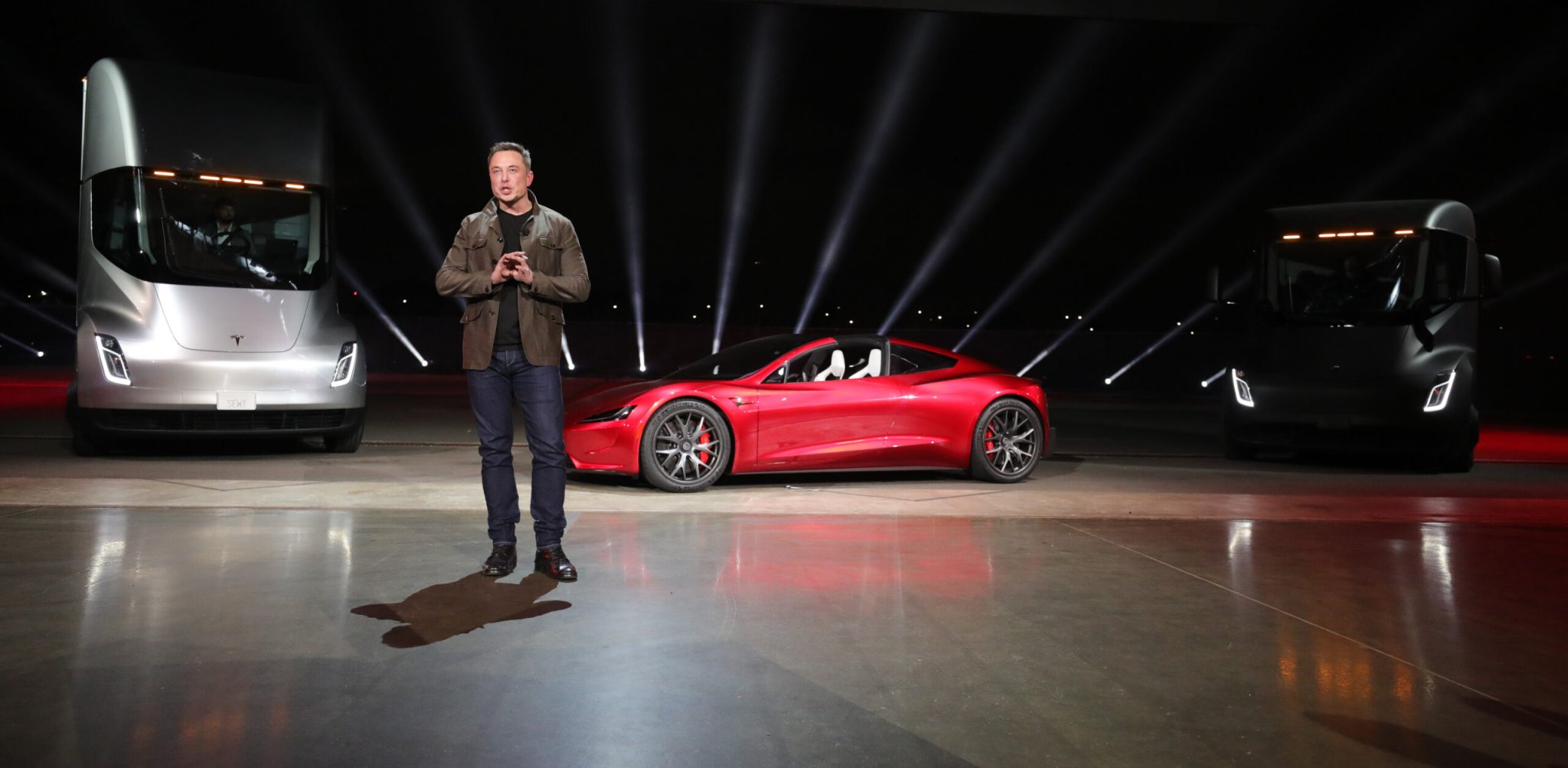

At a theatrical, hype-filled event Thursday night in an aircraft hanger in Hawthorne, California, Elon Musk finally revealed Tesla’s long-expected electric semi truck. He then surprised the audience by unveiling another product that emerged from one of those trucks—a bright red Roadster, an updated version of the company’s first vehicle.
The Roadster, which he said will be available in 2020, will cost $200,000. You can reserve one right now for a cool $50,000. Musk didn’t reveal a sticker price for the new semi truck, but the company is accepting $5,000 reservations for that vehicle, too, even though production isn’t scheduled to start until 2019.
But Tesla is known as much for its ambition as it is for its vehicle delivery delays; the pre-order deposit is a familiar tactic, too. And the current shortage of Model 3 cars looms over the elaborate spectacle of the semi-truck and Roadster announcement. The company accepted hundreds of thousands of reservations for the $35,000 electric daily driver at $1,000 apiece, but so far has only delivered more than 200 of them.
Welcome to the circus
Elon Musk is a modern-day P.T. Barnum, says Arthur Wheaton, an expert on the automotive industry at Cornell University’s School of Industrial and Labor Relations. “He’s extremely enthusiastic in his goals, believes in his mission, but I think the actual practical day-to-day and what it really takes—I think he vastly underestimates,” he says.
Tesla has not responded to a request for comment.
“Taking the money and then promising you something later has gotten him in some trouble for the Model 3,” Wheaton adds. “Now people who put their $1000 down for the Model 3—they may not get it for another entire year.” (The reservation is refundable, but has been known to happen slowly.)
Unlike the Roadster, the Model 3 is meant to be a family’s main car. While the company’s website will give customers an estimate of when they might get it, the long delays for people who are hoping to use the Model 3 as their primary vehicle can affect a family’s real-life logistics. The Model 3, in contrast to the Roadster, isn’t aimed at people who don’t mind parking a lot of money in Tesla’s coffers and waiting for their toy to arrive later.
Musk promises that the new Roadster will be “the fastest production car ever made, period.” It will be able to accelerate from zero to 60 in just 1.9 seconds, clock a quarter mile in 8.9 seconds, and hit a top speed of over 250 miles per hour. For comparison, a 2017 Porsche 911 GT3 take 3.2 seconds to hit 60 mph—over a second slower.
“The point of doing this,” Musk said, “is just [to] give a hardcore smackdown to gasoline cars.” And while it’s true that the Roadster demonstrates that an electric vehicle can compete with the best internal combustion-driven supercars on the spec sheet, other factors—like price and availability—are more likely to be what holds people back from adopting them.
The cars are worlds apart in terms of performance and target audience, but they still rely on Tesla’s underlying battery technology and supply chain. One of the company’s key problems in the Model 3 production stemmed from the batteries, which they make in a Nevada facility called the Gigafactory.

About that truck
Ostensibly, the Tesla event was a reveal for the electric semi. Musk stood in front of two sleek trucks, one silver, one grey, and rattled off stats: the battery-powered vehicle will be able to do zero to 60 mph in five seconds if it’s unweighted; pulling a full load, it would take 20 seconds to do the same.
The key question for electric vehicles is their range, and this one will boast one of 500 miles, Musk said. That figure was a surprise for Glen Kedzie, the energy and environmental counsel at the American Trucking Associations.
“I was expecting something in the range [of] around 300 [miles],” Kedzie says. He was also struck by the truck’s advertised acceleration rates, as well a guarantee from Musk that it wouldn’t break down, even in a million miles. That pledge “far exceeds any standard warranty in the tradition diesel world today, so that was very eye-opening,” Kedzie says.
Musk said that the new trucks will be cheaper to operate than a diesel vehicle on a per-mile basis by a difference of 25 cents—and driving one will yield a fuel savings of more than $200,000, according to Tesla’s website—but the company still hasn’t said what the sticker price actually is.
In short, while we heard a lot of impressive metrics during the event, that key number remains unknown. “We still don’t have any indication what it’s going to cost to get into one of these trucks, and that’s a major concern,” Kedzie says. And of course, if Tesla’s past is any indication of its future, those trucks could be delayed.
David Ross Keith, an assistant professor of system dynamics at MIT’s Sloan School of Management, says that the new truck “exceeded analyst expectations.”
“More broadly, the challenge for Tesla is now execution,” he comments, via email. “The Tesla Truck and the new Roadster are promising concepts, but they also have existing Model S & X drivers who want better Autopilot software, well-documented challenges getting Model 3 production started, and other products such as solar roof tiles already on the table.”
